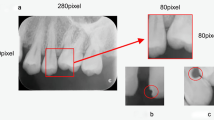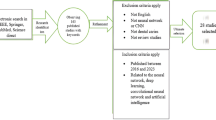Abstract
Dental caries detection holds the key to unlocking brighter smiles and healthier lives by identifying one of the most common oral health issues early on. This vital topic sheds light on innovative ways to combat tooth decay, empowering individuals to take control of their oral health and maintain radiant smiles. This research paper delves into the realm of transfer learning techniques, aiming to elevate the precision and efficacy of dental caries diagnosis. Utilizing Keras ImageDataGenerator, a rich and balanced dataset is crafted by augmenting teeth images from the Kaggle teeth dataset. Five cutting-edge pre-trained architectures are harnessed in the transfer learning approach: EfficientNetV2B3, VGG19, InceptionResNetV2, Xception, and ResNet50, with each model, initialized using ImageNet weights and tailored top layers. A comprehensive set of evaluation metrics, encompassing accuracy, precision, recall, F1-score, and false negative rates are employed to gauge the performance of these architectures. The findings unveil the unique advantages and drawbacks of each model, illuminating the path to an optimal choice for dental caries detection using Grad-CAM (Gradient-weighted Class Activation Mapping). The testing accuracies achieved by EfficientNetV2B3, VGG19, InceptionResNetV2, Xception, and ResNet50 models stand at 95.89%, 96.58%, 93.15%, 93.15%, and 94.18%, respectively. The Training accuracies stood at 100%, 99.91%, 100%, 100% and 100%, meanwhile on validation we achieved 97.63%, 96.68%, 98.82%, 96.68%, and 100% accuracies for EfficientNetV2B3, VGG19, InceptionResNetV2, Xception, and ResNet50 models respectively. Capitalizing on transfer learning and juxtaposing diverse pre-trained architectures, this research paper paves the way for substantial advancements in dental diagnostic capabilities, culminating in enhanced patient outcomes and superior oral health.






























Similar content being viewed by others
References
Aayush J, Tiwari H, Singh U, Kumar N, Kumar S (2023) Dental caries detection using faster R-CNN and YOLO V3. ITM Web Conf 53:02005. https://doi.org/10.1051/itmconf/20235302005
Aeini F, Mahmoudi F (2010) Classification and numbering of posterior teeth in bitewing dental images. In: 2010 3rd international conference on advanced computer theory and engineering (ICACTE), pp 6. https://doi.org/10.1109/ICACTE.2010.5579369
AlSayyed A, Taqateq A, Al-Sayyed R, Suleiman D, Shukri S, Alhenawi E, Albsheish A (2023) Employing CNN ensemble models in classifying dental caries using oral photographs. Int J Data Netw Sci 7(4):1535–1550
Anny Y, Nugroho AS, Amaliah B, Arifin AZ (2012) Classification and numbering of dental radiographs for an automated human identification system. TELKOMNIKA Telecommun Comput Electron Control. 10:137. https://doi.org/10.12928/telkomnika.v10i1.771
Balasubramaniam S, Vijesh Joe C, Sivakumar TA, Prasanth A, Satheesh Kumar K, Kavitha V, Dhanaraj RK (2023) Optimization enabled deep learning-based DDoS attack detection in cloud computing. Int J Intell Syst 2023:2039217. https://doi.org/10.1155/2023/2039217
Braveen M, Nachiyappan S, Seetha R, Anusha K, Ahilan A, Prasanth A, Jeyam A (2023) ALBAE feature extraction based lung pneumonia and cancer classification. Soft Comput 16:1–14. https://doi.org/10.1007/s00500-023-08453-w. (Epub ahead of print. PMID: 37362264; PMCID: PMC10187954)
Chen DS, Yang C-M, Chen M-J, Chen M-C, Weng R-M, Yeh C-H (2023) Deep learning-based recognition of periodontitis and dental caries in dental X-ray images. Bioengineering 10(8):911. https://doi.org/10.3390/bioengineering10080911
Devi DSR, Kostova NM (2020) Cancer medicine: a missed opportunity. Lancet 395(10232):1257–1258. https://doi.org/10.1016/S0140-6736(20)30175-6. (PMID: 32305090)
Haghanifar A, Majdabadi MM, Ko SB, Haghanifar S, Choi Y, KO SB (2023) PaXNet: Tooth segmentation and dental caries detection in panoramic X-ray using ensemble transfer learning and capsule classifier. Multimedia Tools Appl 82:1–21. https://doi.org/10.1007/s11042-023-14435-9
Heck K, Kunzelmann K-H, Walter E, Kaisarly D, Hoffmann L, Litzenburger F (2023) Proximal caries detection using short-wave infrared transillumination at wavelengths of 1050, 1200 and 1300 nm in permanent posterior human teeth. Diagnostics 13(20):3257. https://doi.org/10.3390/diagnostics13203257
Huang C, Wang J, Wang S, Zhang Y (2023) A review of deep learning in dentistry. Neurocomputing 554:126629
Jayachitra S, Prasanth A, Hariprasath S, Benazir Begam R, Madiajagan M (2023) AI enabled internet of medical things in smart healthcare. In: Bhushan B, Sangaiah AK, Nguyen TN (eds) AI models for blockchain-based intelligent networks in IoT systems. Engineering cyber-physical systems and critical infrastructures, vol 6. Springer, Cham. https://doi.org/10.1007/978-3-031-31952-5_7
Jiang H, Zhang P, Che C, Jin B, Zhu Y (2023) CariesFG: A fine-grained RGB image classification framework with attention mechanism for dental caries. Eng Appl Artif Intell 123:106306
Kavitha M, Roobini S, Prasanth A, Sujaritha M (2022) Systematic view and impact of artificial intelligence in smart healthcare systems, principles, challenges and application. In: Shaikh TA, Hakak S, Rasool T, Wasid M (eds) Machine learning and artificial intelligence in healthcare systems. CRC Press, Boca Raton, pp 25–56. https://doi.org/10.1201/9781003265436-2
Lee JH, Kim DH, Jeong SN, Choi SH (2018) Detection and diagnosis of dental caries using a deep learning-based convolutional neural network algorithm. J Dent 77:106–111. https://doi.org/10.1016/j.jdent.2018.07.015. (Epub 2018 Jul 26 PMID: 30056118)
Lian L, Zhu T, Zhu F, Zhu H (2021) Deep learning for caries detection and classification. Diagnostics 11(9):1672. https://doi.org/10.3390/diagnostics11091672
Lin PL, Lai YH, Huang PW (2010) An effective classification and numbering system for dental bitewing radiographs using teeth region and contour information. Pattern Recogn 43:1380–1392. https://doi.org/10.1016/j.patcog.2009.10.005
Liu L, Xu J, Huan Y, Zou Z, Yeh SC, Zheng LR (2020) A smart dental health-IoT platform based on intelligent hardware, deep learning, and mobile terminal. IEEE J Biomed Health Inform 24(3):898–906. https://doi.org/10.1109/JBHI.2019.2919916. (Epub 2019 Jun 7 PMID: 31180873)
Mahoor M, Abdel-Mottaleb M (2005) Classification and numbering of teeth in dental bitewing images. Pattern Recogn 38:577–586. https://doi.org/10.1016/j.patcog.2004.08.012
Mendonça EA (2004) Clinical decision support systems: perspectives in dentistry. J Dent Educ 68(6):589–597 (PMID: 15217078)
Mohammad-Rahimi H, Motamedian SR, Rohban MH, Krois J, Uribe SE, Mahmoudinia E, Rokhshad R, Nadimi M, Schwendicke F (2022) Deep learning for caries detection: a systematic review. J Dent 122:104115. https://doi.org/10.1016/j.jdent.2022.104115. (Epub 2022 Mar 30 PMID: 35367318)
Ntovas P, Michou S, Benetti AR, Bakhshandeh A, Ekstrand K, Rahiotis C, Kakaboura A (2023) Occlusal caries detection on 3D models obtained with an intraoral scanner. A validation study. J Dent 131:104457. https://doi.org/10.1016/j.jdent.2023.104457. (Epub 2023 Feb 28 PMID: 36858167)
Olsen GF, Brilliant SS, Primeaux D, Najarian K (2009) An image-processing enabled dental caries detection system. In: 2009 ICME international conference on complex medical engineering, Tempe, AZ, USA, 2009, pp 1–8. https://doi.org/10.1109/ICCME.2009.4906674
Oztekin F, Katar O, Sadak F, Yildirim M, Cakar H, Aydogan M, Ozpolat Z, Talo Yildirim T, Yildirim O, Faust O et al (2023) An explainable deep learning model to prediction dental caries using panoramic radiograph images. Diagnostics 13:226. https://doi.org/10.3390/diagnostics13020226
Pan SJ, Yang Q (2010) A survey on transfer learning. IEEE Trans Knowl Data Eng 22(10):1345–1359. https://doi.org/10.1109/TKDE.2009.191
Park EY, Cho H, Kang S, Jeong S, Kim EK (2022) Caries detection with tooth surface segmentation on intraoral photographic images using deep learning. BMC Oral Health 22(1):573. https://doi.org/10.1186/s12903-022-02589-1.PMID:36476359;PMCID:PMC9730679
Peres MA, Macpherson LMD, Weyant RJ, Daly B, Venturelli R, Mathur MR, Listl S, Celeste RK, Guarnizo-Herreño CC, Kearns C, Benzian H, Allison P, Watt RG (2019) Oral diseases: a global public health challenge. Lancet 394(10194):249–260. https://doi.org/10.1016/S0140-6736(19)31146-8. (Erratum in: Lancet. 2019 Sep 21;394(10203):1010. PMID: 31327369)
Pitts NB, Zero DT, Marsh PD, Ekstrand K, Weintraub JA, Ramos-Gomez F, Tagami J, Twetman S, Tsakos G, Ismail A (2017) Dental caries. Nat Rev Dis Primers 25(3):17030. https://doi.org/10.1038/nrdp.2017.30. (PMID: 28540937)
Prados-Privado M et al (2020) Dental caries diagnosis and detection using neural networks: a systematic review. J Clin Med 9(11):3579. https://doi.org/10.3390/jcm9113579
Qayyum A, Tahir A, Butt MA, Luke A, Abbas HT, Qadir J, Arshad K, Assaleh K, Imran MA, Abbasi QH (2023) Dental caries detection using a semi-supervised learning approach. Sci Rep 13(1):749. https://doi.org/10.1038/s41598-023-27808-9.PMID:36639724;PMCID:PMC9839770
Rad AE, Rahim MS, Norouzi A (2013) Digital Dental X-Ray Image Segmentation and Feature Extraction. TELKOMNIKA Indones J Electr Eng 11:3109–3114. https://doi.org/10.11591/telkomnika.v11i6.2655
Rajee MV, Mythili C (2023) Dental image segmentation and classification using inception Resnetv 2. IETE J Res 69(8):4972–4988. https://doi.org/10.1080/03772063.2021.1967793
Said EH, Nassar DEM, Fahmy G, Ammar HH (2006) Teeth segmentation in digitized dental X-ray films using mathematical morphology. IEEE Trans Inf Forensics Secur 1(2):178–189. https://doi.org/10.1109/TIFS.2006.873606
Schwendicke F, Elhennawy K, Paris S, Friebertshäuser P, Krois J (2020) Deep learning for caries lesion detection in near-infrared light transillumination images: a pilot study. J Dent 92:103260. https://doi.org/10.1016/j.jdent.2019.103260. (Epub 2019 Dec 9 PMID: 31821853)
Selwitz RH, Ismail AI, Pitts NB (2007) Dental caries. Lancet 369(9555):51–59. https://doi.org/10.1016/S0140-6736(07)60031-2. (PMID: 17208642)
Shah S, Abaza A, Ross A, Ammar H (2006) Automatic tooth segmentation using active contour without edges. In: 2006 biometrics symposium: special session on research at the biometric consortium conference, pp 1–6. https://doi.org/10.1109/BCC.2006.4341636.
Shen D, Wu G, Suk HI (2017) Deep learning in medical image analysis. Annu Rev Biomed Eng 19:221–248. https://doi.org/10.1146/annurev-bioeng-071516-044442. (Epub 2017 Mar 9. PMID: 28301734; PMCID: PMC5479722)
Sonavane A, Yadav R, Khamparia A (2021) Dental cavity classification of using convolutional neural network. In: IOP conference series: materials science and engineering, vol 1022, No 1. IOP Publishing, Bristol
Tareq A et al (2023) Visual diagnostics of dental caries through deep learning of non-standardised photographs using a hybrid YOLO ensemble and transfer learning model. Int J Environ Res Public Health 20(7):5351. https://doi.org/10.3390/ijerph20075351
Teeth Dataset: teeth_dataset|Kaggle. (n.d.). Retrieved from https://www.kaggle.com/pushkar34/teethdataset? Accessed 10 Aug 22
Thanh MTG, Van Toan N, Ngoc VTN, Tra NT, Giap CN, Nguyen DM (2022) Deep learning application in dental caries detection using intraoral photos taken by smartphones. Appl Sci 12(11):5504. https://doi.org/10.3390/app12115504
Tuzoff DV, Tuzova LN, Bornstein MM, Krasnov AS, Kharchenko MA, Nikolenko SI, Sveshnikov MM, Bednenko GB (2019) Tooth detection and numbering in panoramic radiographs using convolutional neural networks. Dentomaxillofac Radiol 48(4):20180051. https://doi.org/10.1259/dmfr.20180051. (Epub 2019 Mar 5. PMID: 30835551; PMCID: PMC6592580)
Author information
Authors and Affiliations
Corresponding author
Additional information
Publisher's Note
Springer Nature remains neutral with regard to jurisdictional claims in published maps and institutional affiliations.
Rights and permissions
Springer Nature or its licensor (e.g. a society or other partner) holds exclusive rights to this article under a publishing agreement with the author(s) or other rightsholder(s); author self-archiving of the accepted manuscript version of this article is solely governed by the terms of such publishing agreement and applicable law.
About this article
Cite this article
Inani, H., Mehta, V., Bhavsar, D. et al. AI-enabled dental caries detection using transfer learning and gradient-based class activation mapping. J Ambient Intell Human Comput (2024). https://doi.org/10.1007/s12652-024-04795-x
Received:
Accepted:
Published:
DOI: https://doi.org/10.1007/s12652-024-04795-x




